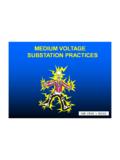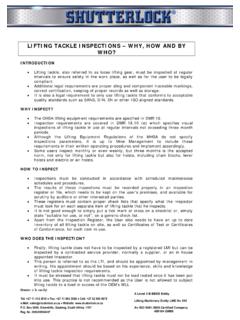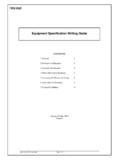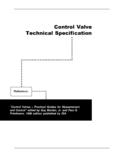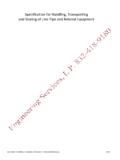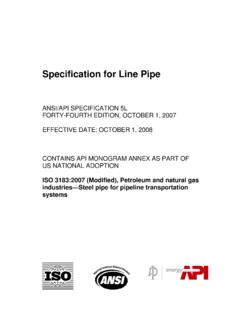Transcription of Guide to lifting equipment testing inspections …
1 lifting equipment training, plant audits, registers and codes of practice. P O Box 3757, CRAMERVIEW, 2060 RSA Tel / Fax: +27 11 462 9620/1 Cell +27 82 372 4595. Website: Email: Guide TO lifting equipment testing AND inspections . There appears to be a lot of confusion in the work place, including at major construction sites, Mines and Plants regarding the legal requirements for the inspection and/or testing of lifting equipment , which includes lifting machines, lifting tackle, hoists and fabricated lifting equipment . In an effort to provide guidance to users, inspectors, safety and management staff, we hereby submit the following information. It must be stressed that the information supplied is the writer's opinion and provided without any malice or prejudice towards any manufacturer, supplier, user or service provider.
2 For the purpose of this document the following abbreviations apply: MHSA Mine Health and Safety Act OHSA Occupational Health and Safety Act DOL Department of Labour DMR Department of Minerals ECSA Engineering Council of South Africa DMR 18 OHSA Driven Machinery Regulation 18. LME lifting Machinery Entity registered with the DOL. LMI lifting Machinery Inspector registered wit ECSA. LTI Appointed lifting tackle inspector LE lifting equipment LM lifting Machine LT lifting Tackle CR OHSA Construction Regulations OEM Original equipment Manufacturer WLL Working load limit as specified by OEM. SWL Safe working load 1. Visual inspections compared to Examinations. A visual inspection is done by visually checking all visible components (SANS. 500) of a sling or hoist for example, and completing a properly prepared check list.
3 This can be done by a person or inspector, appointed in writing by virtue of the person's knowledge, experience and training. An examination is a detailed study by a competent person in such depth and detail as he considers necessary to enable him /her to determine whether the equipment being examined is safe to remain in use (SANS 500) This could include stripping a unit, and conducting an operational test such as on a hoist. An examination should be done by a LMI or competent appointed technician or artisan. Pg. 1. Directors: P H Otto, M P Otto Reg No 1999/080640/7 Vat No 4090206469. lifting equipment training, plant audits, registers and codes of practice. P O Box 3757, CRAMERVIEW, 2060 RSA Tel / Fax: +27 11 462 9620/1 Cell +27 82 372 4595. Website: Email: It must also be noted that a new updated Draft DMR 18 has been published by the DOL under in Government Gazette #34052 of March 4, 2011.
4 These new OHSA DMR 2015 Regulations should be promulgated hopefully by the middle of 2015. The contents of the new Regulations could affect inspection and testing requirements. New LE Definitions will also be published. As a start it is common knowledge that all lifting machines, which are classified according to different Codes in Appendix 12 of the OHSA, DMR, must be load tested (performance tested) at intervals not exceeding 12 months. This load test must be conducted by a DOL registered LME. This actual load test must be conducted, or be supervised by an ECSA registered LMI. The LMI is assessed and found competent by ECSA. The LMI can only test the types of lifting machines that he has been registered for, as a LMI by ECSA. Note: ECSA do not print the scope of competence of the LMI on his LMI certificate.
5 The only method for the user to establish whether this LMI is competent to load test a specific type of machine, is to request a copy of his ECSA confirmation of registration letter which reflects the scope of his competence. Note: Where the MHSA does not specify any issue relating to health and safety, such as OHSA LME/LMI requirements, the requirements of the OHSA DMR 18 apply by interpretation of the MHSA Section 103. The following questions are regularly asked in the work place. Our comments, if not a legal requirement, is provided based on best practice. 2. Who is a Competent Person to conduct examinations, as well as inspections of lifting Machines? As there is no definition for a Competent Person (CP) in the DMR, one should consider the definition of a CP as it is specified in the OHSA CR, as these where published in 2003 and since been updated, compared to the DMR which was published in 1993.
6 No recent updates in DMR have mentioned the definition for a CP other than the requirements for an LMI. It is clear that the LMI has to conduct, or supervise the periodic actual load testing of lifting machines, but it is not clear whether the 6 monthly thorough examinations have to be conducted by a LMI. The Draft DMR 2015 mentions a person with knowledge and experience . and therefore would imply that, in future, you would not have to be a LMI to do these thorough examinations. Comment: Wait for the new DMR definitions, but at least appoint someone in writing, with the necessary back ground, experience and training to conduct these thorough examinations, according to SANS standards and properly prepared check lists, without stripping or disassembling the machine. Directors: P H Otto, M P Otto Reg No 1999/080640/7 Vat No 4090206469.
7 lifting equipment training, plant audits, registers and codes of practice. P O Box 3757, CRAMERVIEW, 2060 RSA Tel / Fax: +27 11 462 9620/1 Cell +27 82 372 4595. Website: Email: 3. Must a lifting tackle inspector (LTI) be a LMI? The answer is no. It must be stressed that a LTI does not have to be a registered LMI. The purpose and reason for appointing LMI's is to conduct, or supervise lifting machine load testing only, and although they have to be qualified or competent to inspect lifting tackle as well, they should be competent to inspect lifting tackle as well. This issue was cleared up with government notice No: GRN 257 of the 7th of March 2008; This registration does not apply to persons who examine lifting tackles in terms of regulation 18 (10) (e) of the Driven Machinery Regulations.. 4. Who can inspect lifting tackle?
8 lifting tackle has to be inspected, at least every 3 months by a LTI who should keep a register of these inspections on site. This is a specific requirement in terms of DMR (e). It must be noted that inspections can be conducted at more frequent intervals if so required by the user. No specific inspection periods are specified in the MHSA, Chapter 8 Regulations and mines have to specify in their Standard Operating Procedures (SOP) their inspection method, requirements , inspector qualifications etc. Persons who inspect LT are suitably qualified persons, who by virtue of their knowledge, experience and training, are appointed in writing, by their employer to do. There is currently no DOL requirement to register LTI's, although this is anticipated in future. Nothing has changed and these inspections can be conducted by in house appointed LTI's or contracted service providers, obviously at a cost to the user.
9 If the user is using a service provider to conduct these inspections , the user should insist on the contractor's staff providing proof of training and experience, and that they have been appointed, in writing, by their employer. 5. Must lifting tackle in use be subjected to annual load testing ? The answer is an emphatic NO. Over the last few years this practice has become popular, mostly as a result of the user's ignorance due to lack of training, as well as service providers who provide this service for commercial reasons only and therefore promote it. It must be stated that manufacturers of chain, wire rope and webbing, are totally against this practice as: (a) It is not a legal requirement in terms of OHSA DMR 18 (10) or any MHSA. Chapter 8 Regulations to conduct periodic load testing on slings. Directors: P H Otto, M P Otto Reg No 1999/080640/7 Vat No 4090206469.
10 lifting equipment training, plant audits, registers and codes of practice. P O Box 3757, CRAMERVIEW, 2060 RSA Tel / Fax: +27 11 462 9620/1 Cell +27 82 372 4595. Website: Email: (b) It can be detrimental to the service life of a sling or component as a test in excess of the WLL can develop a latent defect in the sling that could cause it to fail later on, under repeated loading. For example, to subject a sling with a WLL of 5 ton, that is 5 years old, to a static test load of 10 ton, which is equal to a 100% overload, can be detrimental or damaging to the sling, or to certain components of the sling such as hooks and coupling links etc. (c) All OEMs specify a WLL for the size and type of sling supplied. This WLL is specified in the Standard, such as a SANS, to which the sling or product is made. The Standard as well as the OEM will state that the sling must not be subjected to a load in excess of this WLL.



